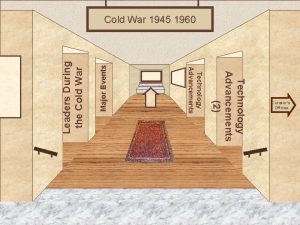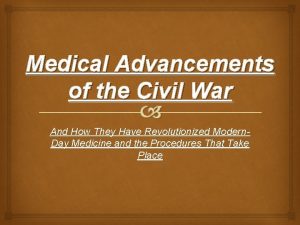CIVIL WAR TECHNOLOGICAL ADVANCEMENTS Nick Ouellette Sarah Nuzzo









- Slides: 9

CIVIL WAR: TECHNOLOGICAL ADVANCEMENTS Nick Ouellette, Sarah Nuzzo, Sara Matoshi, Faith Mauri, and Jon Civiello

MEDICINE IN THE CIVIL WAR § Anesthesia was used for 90% of injuries during the war and it came around in 1846 § The two main types of anesthesia were ether and chloroform § Surgeries took place in a "field hospital" and the soldiers were divided by their needs § 75% of amputees survived and their limbs were thrown into a large pile in the field § No antibiotics were available and there was no attempt for sterility

MEDICINE IN THE CIVIL WAR § In order to be a doctor for the soldiers, two years of schooling was required. Many doctors went into war unable of knowing what to do § Makeshift hospitals were made from barns, churches, and warehouses § Larger hospitals were set up in cities that cared for the soldiers that needed extra and longer care § Doctors made up random cures to stop disease from spreading and causing an epidemic break out § The most common cause of death was disease, around 2/3, or 620, 000 soldiers died from this

MEDICINE IN THE CIVIL WAR § Advancements in medical technology varied from cures, transportation, and surgeries. § At first doctors believed mercury was a good substance to treat the ill, instead of treating the wounded, soldiers fell even more sick and eventually died. Those who were lucky to survive had to suffer through the side effects after. § Transportation was hard in the war because soldiers would have to leave the battlefield to bring the hurt to the hospitals. Stretcher bearers were used so they would only have to transport the hurt, so they wouldn’t have to leave the war. As the war grew on, horses and wagons were used for faster transportation and were on-the-road hospitals. § As injuries got worse, doctors invented many new ways to treat a soldier. Plastic surgery was invented to cover up the deadly wounds and rebuild the face. Brain surgery also treated the pains of an injured brain by relieving pain.

CIVIL WAR ADVANCEMENTS IN MILITARY TECHNOLOGY • To combat against the ironclad ships the Union used to blockade the confederate ports, the Confederates used newly developed submarines to take down these ships. • The first of these submarines was the C. S. S Hunley, a metal tube that was 40 feet long, 4 feet across, and held an 8 -man crew. • "In 1864, the Hunley sank the Union blockade ship Housatonic off the coast of Charleston but was itself wrecked in the process. "

Civil War Advancements in Military Technology Many weapons were used in the civil war, such as: *knives *swords *firearms(pistols, muskets, rifles, etc. ) The Civil war was a time of great social and political change as well as technological change. The inventors and military man developed new types of weapons; such as the repeating rifle and the submarine. These inventions forever changed the way that wars were fought.

NEW WAYS OF COMMUNICATION § The primary new advancement in communication technology is the telegraph § Prior to the telegraph, people communicated via talking and sending messengers on horses § Provided better communication for situations of war (Civil War) § In this case the Union had the advantage because the Confederates lacked the industrial ability to conduct such a large scale communication campaign § This gave the Union more ability to monitor the battlefield and assess the situation quicker and with more accuracy § One advantage was that there was less of a chance of a telegram being stolen than a message sent by foot

EXAMPLES OF WEAPONRY ADVANCEMENTS § The Gatling Gun § The Minie Bullet "The ancestor of the modern machine gun, it was the most successful of several rapid-fire guns that were born before the war. Richard Gatling invented the gun in the hopes that a weapon so catastrophic in its damage would convince men to stop waging war. Unfortunately, its efficiency in killing only made war more deadly. It was not used extensively during the Civil War. " "The Minie bullet made defense even safer. When used in the rifled musket it spun faster, traveled further and was five times more accurate than any single-man weapon. Able to kill at half a mile, it was the largest contributor to battle wounds (more than 90%). "

WORKS CITED § Civil War Innovations. www. pbs. org/opb/historydetectives/feature/ civil-war-innovations/. Accessed 1 Nov. 2017. § "Civil War Medicine. " Slide Share, 30 June 2011, www. slideshare. net/cldomin 1/ civil-war-medicine. Accessed 1 Nov. 2017. § "Civil War Submarine. " American War Story, Americanwarstory. com, 2016, www. americancivilwarstory. com/civil-war-submarine. html. Accessed 3 Nov. 2017. § "Civil War Technology. " History. com, History channel, 2017, www. history. com/ topics/american-civil-war/civil-war-technology. Accessed 31 Oct. 2017. § Dixon, Ina. "Modern Medicines Civil War Legacy. " Civil War Trust, 29 Oct. 2013, www. civilwar. org. Accessed 27 Oct. 2017. § Echols, Michael, editor. "American Civil War Medicine & Surgical Antiques. " Medical Antiques Index, Dr. Arbittier or Dr. Echols, 17 Oct. 2017, www. medicalantiques. com/civilwar/index. htm. Accessed 1 Nov. 2017. § Goellnitz, Jenny. "Civil War Medicine. " Ehistory, ehistory. osu. edu/exhibitions/ cwsurgeon/introductio. Accessed 3 Nov. 2017. § Williams, Mary. "Medicine in the American Civil War. " CPR Certified, edited by Mary Williams, www. cprcertified. com/medicine-in-the-american-civil-war. Accessed 31 Oct. 2017. § Uschan, Michael V. A Civil War Doctor. Farmington Hills, Lucent Books, 2005. The Working Life.

















